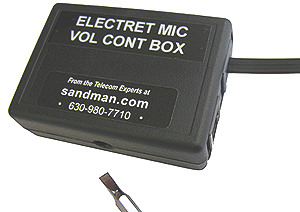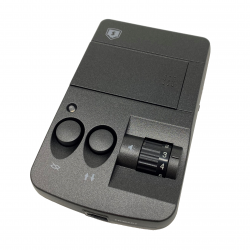Is it Noisy? You probably don't need an amplified handset!
As one of the last companies manufacturing amplified handsets, we get a ton of calls from people looking for an amplified handset. The first thing we ask is whether it's for someone who can't hear, or for a noisy area.
A good percentage of our customers don't know if it's noisy. They were just told to order an amplified handset, or maybe that's just what the customer requested.
The problem with putting an amplified handset in a noisy area is that it makes it harder to hear, not easier.
The transmitter in the handset picks up the background noise, the amplifier amplifies the background noise when the wheel is turned up, and the background noise is even louder and it's even harder to hear the person on the other end of the call.
All phones sold in the last couple decades have a receiver amplifier built in. There’s usually a volume up and down button on the base of the set. If it's noisy and you turn up the volume on the set, the background noise is increased along with the other party's voice. It's just as hard or harder to hear.
When you put a handset with a noise cancelling transmitter on the phone it cuts out most of the background noise. When the volume is turned up the person on the other end is easier to hear, not harder.
We can put a noise cancelling transmitter in most phone handsets, but not all. Some of them are designed to look "cool" and are so small inside that we can't get a noise cancelling transmitter in it.
For phones that we can't make a noise cancelling handset for, we have a Volume Control Box to reduce the mic level if it's noisy (using a small screwdriver to adjust a tiny pot). That's not a terrible idea since if it's noisy it's likely that the user will be speaking louder anyway. It simply plugs into the phone's handset jack and the handset cord plugs into it. It only works on phones with electret transmitters (either polarity), which is just about all of them these days.

Another option is to put in a different model phone that we can make a noise cancelling handset for.
Most of our customers who have gone through this before know that if they sell a customer an amplified handset for a noisy area, the customer will probably return it. They already know to do a consultative sell when dealing with amplified handsets. If it's noisy, they check with us to see if a noise cancelling handset is available before quoting it.
If we don't have a noise cancelling handset for the type of phones you normally sell, ask the manufacturer to call us. We've worked with many manufacturers to create a noise cancelling handset for their system.
Not having an amplified or noise cancelling handset for the phones where it's needed has led to a lot of bad blood when a new system is put in. Sometimes the salesman didn't ask about it. Having to pull out a phone system and put the old one back makes for a very bad day (lots of our customers call us in a panic).
Be sure your salesmen ask about special stuff like amplified handsets when you're giving a quote on a new phone system. Call us to get the pricing and availability on what you're selling so you have your ducks in a row up-front, and don't have to panic later.
A lot of our customers get an amplified AND noise cancelling handset. The benefit of both amplified and noise cancelling in a handset is that the user can raise the receive volume using their fingertips. They don't have to go back to the phone to adjust the volume. On some phones when the handset is hung-up the volume that had been raised using the buttons on the phone returns to normal. With the amplifier in the handset, the volume level remains the same (set by the wheel) because the user doesn't adjust the phone's volume control.
For a technical explanation of how our noise cancelling handsets work, click HERE.
If the user needs an amplified handset because they can't hear well, we make them for most phones. We also have an In-line Telephone Amplifier that works with all phones with the dial in the base, except RCA and GE phones.

If the user wears a hearing aid, it would be a good idea to look at our Hearing Aid Compatibility Tech Bulletin. It explains what needs to be done to get the T-Coil in the hearing aid to work with the handset on the phone.
When the T-Coil is activated on a hearing aid, the hearing aid's mic that's normally used to pick up sounds is switched off, which reduces the annoying squeal. The hearing aid then uses a coil of wire inside of it to receive the audio from the phone's handset by induction. Just like the old suction cup telephone recording gizmos from years ago.

 Products
Products